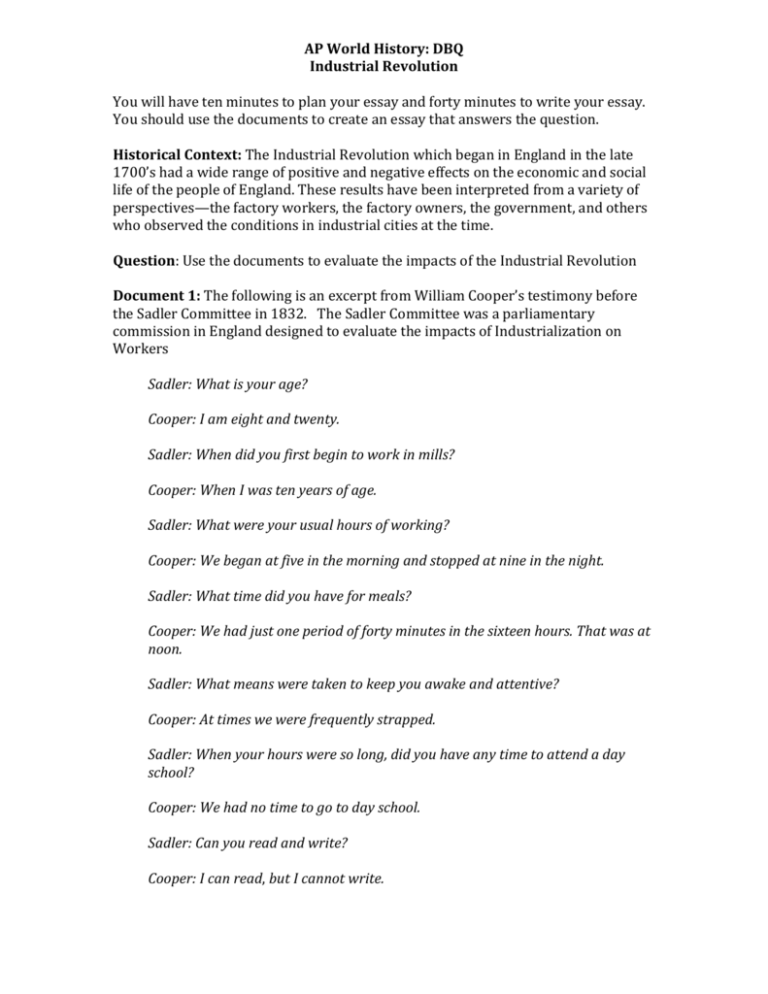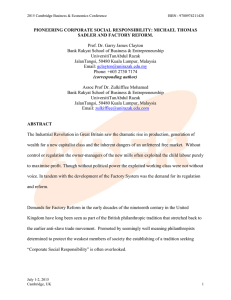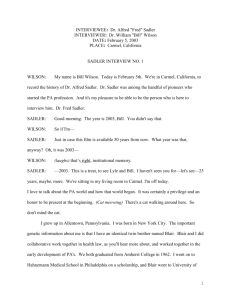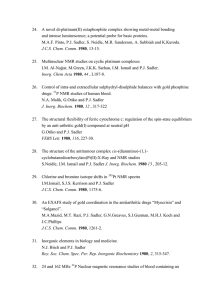AP World History: DBQ Industrial Revolution You will have ten
advertisement

AP World History: DBQ Industrial Revolution You will have ten minutes to plan your essay and forty minutes to write your essay. You should use the documents to create an essay that answers the question. Historical Context: The Industrial Revolution which began in England in the late 1700’s had a wide range of positive and negative effects on the economic and social life of the people of England. These results have been interpreted from a variety of perspectives—the factory workers, the factory owners, the government, and others who observed the conditions in industrial cities at the time. Question: Use the documents to evaluate the impacts of the Industrial Revolution Document 1: The following is an excerpt from William Cooper’s testimony before the Sadler Committee in 1832. The Sadler Committee was a parliamentary commission in England designed to evaluate the impacts of Industrialization on Workers Sadler: What is your age? Cooper: I am eight and twenty. Sadler: When did you first begin to work in mills? Cooper: When I was ten years of age. Sadler: What were your usual hours of working? Cooper: We began at five in the morning and stopped at nine in the night. Sadler: What time did you have for meals? Cooper: We had just one period of forty minutes in the sixteen hours. That was at noon. Sadler: What means were taken to keep you awake and attentive? Cooper: At times we were frequently strapped. Sadler: When your hours were so long, did you have any time to attend a day school? Cooper: We had no time to go to day school. Sadler: Can you read and write? Cooper: I can read, but I cannot write. Document 2: Excerpt from the testimony of Joseph Hebergam to the Sadler Committee. The Sadler Committee was a parliamentary commission in England designed to evaluate the impacts of Industrialization on Workers Sadler: What is the nature of your illness? Hebergam: I have damages lungs. My leg muscles do not function properly and will not support of weight of my bones. Sadler: A doctor has told you that you will die within the year, is that correct? Hebergam: I have been so told. Sadler: Did he tell you the cause of your illness? Habergam: He told me that it was caused by the dust in the factories and from overwork and insufficient diet. Sadler: To what was his (your brother’s) death attributed? Hebergam: He was cut by a machine and he died of infection. Sadler: Do you know of any other children who died at the Mill? Hebergam: There were about a dozen died during the two years and a half that I was there. At the Mill where I worked last, a boy was caught in a machine and had both his thigh bones broke and from his knee to his hip the flesh was ripped up the same as it had been cut by a knife. His hand was bruised, his eyes were nearly torn out and his arms were broken. His sister, who ran to pull him off, had both her arms broke and her head bruised. The boy died. I do not know if the girl is dead, but she was not expected to live. Sadler: Did the accident occur because the shaft was not covered? Hebergam: Yes Document 3: This excerpt is from The Philosophy of Manufacturers by factor owner Andrew Ure, 1835. I have visited many factories, both in Manchester and in the surrounding districts, and I never saw a single instance of corporal chastisement [beating] inflicted on a child. They seemed to be always cheerful and alert, taking pleasure in the light play of their muscles. . . .As to exhaustion, they showed no trace of it on emerging from the mill in the evening; for they began to skip about. . . .It is moreover my firm conviction [opinion] that children would thrive better when employed in our modern factories, than if left at home in apartments too often ill-aired, damp, and cold. Document 4: This description is from a pamphlet published in 1797 by the humanitarian organization: The Society for Bettering the Condition and Increasing the Comforts of the Poor. The village contains about 1500 inhabitants, of whom all are capable of work are employed in and about the mills. Of these there are 500 children who are entirely fed, clothed, and educated by Mr. Dale. The others live with their parents in the village and have a weekly allowance for their work. The healthy appearance of these children has frequently attracted the attention of the traveler. Special regulations, adopted by Mr. Dale, have made this factory very different from the others in this kingdom. Out of the nearly 3000 children employed in the mills from 1785 to 1797, only fourteen have died. Document 5: This except, from Manchester in 1844, was written by social reformer Leon Faucher (Frank Cass & Co. Ltd., 1969) after his visit to English faculty towns. The little town of Hyde was at the beginning of the century, a little hamlet of only 800 people, on the summit of a barren hill, the soil of which did not yield sufficient food for the inhabitants. The brothers Ashton have peopled and enriched this desert. . . .Mr. T. Ashton employs 1500 work people [in his factories]. The young women are well and decently clothed. . . . The houses inhabited by the work people form long and large streets. Mr. Ashton has built 300 of them, which he lets [rents] for . . . 75 cents per week. . . . Everywhere is to be observed a cleanliness which indicates order and comfort. Document 6: This excerpt from The Conditions of the Working Class in England was written by industrialist and social activist Friedrich Engels after he visited an English industrial city in 1844. Every great town has one or more slum areas where the workers struggle through life as best they can out of sight of the more fortunate classes of society. The slums . . . are generally unplanned wildernesses of one- or two-storied houses. Wherever possible these have cellars which are also used as dwellings. The streets are usually unpaved, full of holes, filthy and strewn with refuse. Since they have neither gutters nor drains, the refuse accumulates in stagnant, stinking puddles. The view of Manchester is quite typical. The main river is narrow, coalblack and full of stinking filth and rubbish which it deposits on its bank. . . .One walks along a very rough path on the river bank to reach a chaotic group of little, one-story, one- room cabins. . . .In front of the doors, filth and garbage abounded. . . . Document 7: This chart shows the amount of Iron produced by British mills between 1740 and 1790. It was published by a parliamentary commission on industry.








